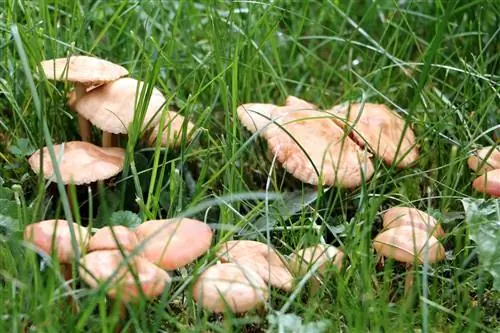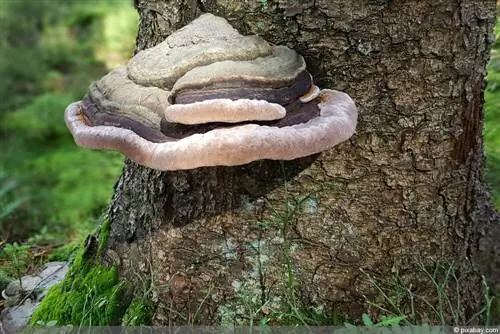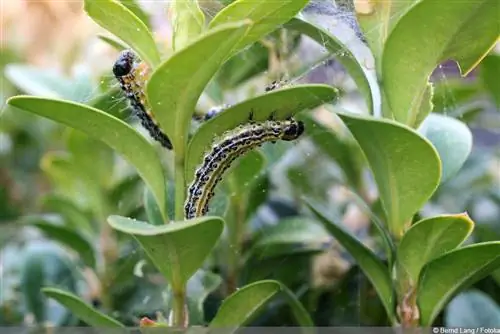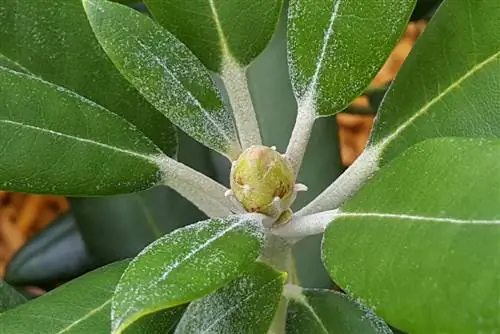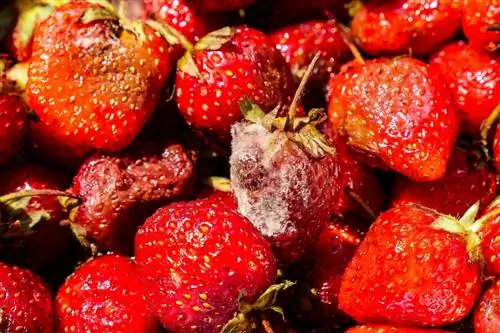- Author admin [email protected].
- Public 2023-12-17 03:39.
- Last modified 2025-01-24 12:45.
The name Goldafter refers to the moth caterpillar, which causes enormous damage, especially to fruit trees and meadows, and appears to be very voracious. Goldafter infestation can drive a gardener to despair and cause trees, shrubs or bushes and perennials to be completely stripped within a short period of time.
Helpful action against Goldafter infestation
When we talk about a Goldafter infestation, we are not talking about an increasing population of the moth in its adult form. It's about the previous stage, the caterpillars, from which moths later develop. The name of these animals has a reason that can be seen with the naked eye. A golden bush of hair on the anus of the adult animals is used to cover the nest and indicates that a large number of caterpillars will soon hatch and attack everything edible in the garden.
Prevention is the best method
Since the caterpillars are the offspring of moths, the gardener should not act until the caterpillars are discovered. If you keep moths out of your garden, you don't have to worry about a population of their offspring. The adult butterflies are easy to recognize and prefer to stay near lights. In the evening it is therefore very effective to set up light traps and capture the moth. The gardener does not know whether he has already laid eggs. However, the moths caught in the light traps provide information about the extent to which Goldafter infestation can be expected. If the gardener has caught a few moths, he should go looking for their nests. These are preferably found in trees. If there are bare spots in the tree, you can almost certainly assume that you will find a gold after nest.
Late autumn is the best time to look for Goldafter nests, as most of the animals have not yet hatched and you can remove the nest and its offspring from the garden. If the population is only discovered in spring, removing the nest in the evening ensures that not only the Goldafter's hoard, but also the pests themselves are removed from the garden. A regular garden inspection prevents a rapidly spreading population, as the nests are easily recognizable thanks to the covering of golden hairs.
Do not use chemicals against Euproctis Chrysorrhoea
When there is a large caterpillar infestation, some gardeners quickly come up with the idea of using chemical weapons to combat the nests and caterpillars. This process is not only advised against in the interests of nature conservation, but the chemical club is also ineffective against Goldafter infestation. It is best to cut off the affected tree and shrub parts with secateurs and dispose of the dead wood along with the nests on it. Since goldfish are out and about during the day and are dedicated to feeding, combating them should preferably be carried out in the evening or early morning. Destroying the empty nest eliminates the animals' habitat, but not their existence in the garden. A Goldafter infestation can be recognized by the enormous web formation, which is particularly evident around the nest. It is therefore hardly possible to miss a nest with hatched and active caterpillars. Removing the nests in autumn is optimal because eggs are always laid in the previous year and the caterpillars do not hatch until the following spring. The best protection is to remove the nests before they hatch and the voracious pests feast on the trees in the garden.
Provide predators of the Goldafter with habitat in the garden
Many bird species have the Goldafter in the caterpillar stage on their menu. The gardener can save himself a lot of trouble and a time-consuming search for nests by hanging nest boxes in the garden and creating a habitat for the local birds. These successfully eliminate the caterpillars and ensure a garden in which you don't have to worry about leaf damage and have to put up with an oversized population of gold after caterpillars. If the Goldafter infestation is very severe, the gardener can support the birds and resort to manual measures. Pruning of infected trees is necessary because the caterpillars can only be removed if their nests are destroyed. Manual collection is less suitable because gold particles usually occur in large quantities and you would not be able to keep up with the collection. A tree or shrub affected by Goldafter looks worrisome. But there is no reason to panic, as the plant recovers very quickly after the nests have been successfully removed by pruning and will sprout again in the same summer.
Note on dealing with gold after nests
The golden hairs that the moth uses to build and cover its nest are stinging hairs. These can lead to a skin reaction. If a gardener wants to act quickly and boldly grabs the nest, this can have unpleasant consequences. Direct skin contact with the stinging hairs should be avoided and thick gloves should be worn when removing the nests. The removed nests and the dead branches can be burned. If there are still Goldafter eggs in the nest, they are automatically killed by the fire and do not pose any further danger to the plants in the garden. Most of the media advises chemical removal and hiring specialists. However, the chemical measures have proven to be of little help in practice and also pose a danger to other animals and microorganisms in the garden. Since the Goldafter is on the menu of local birds, they would ingest the toxins.
Conclusion: Patience and caution are required when fighting gold after caterpillars. The hedge trimmer is the most effective instrument and should be used. All infected branches and twigs, including the nests that can be recognized by the golden hairs and webs around their location, must be pruned and, if possible, burned. Skin contact must be avoided at all costs due to the allergy-promoting stinging hairs.
What you should know about Goldafter in brief
Peculiarities
- The name comes from the golden yellow anal bush, with whose hair the female covers the eggs so that the natural enemies of the insects cannot find them.
- If you have caterpillars in your garden, they are a real plague. They climb everywhere, not just trees and bushes.
- They don't even stop at clothes dryers, furniture, slides and children's toys.
- The bad thing is that they spin everything. It sometimes looks spooky.
- With their barbs, which are called stinging hairs, gold afters trigger allergic reactions.
- The caterpillar itself is protected from predators by these stinging hairs. A single caterpillar has around 600,000 such hairs.
- They break off if the caterpillar is disturbed and remain effective for years.
Countermeasures
You can destroy the webs with a jet of water, but the crawlers are stubborn. They have a web of thread that they use to stick themselves together. This means you can always return to your starting point. The caterpillars also fly around on these threads and settle on hair, clothing and also on the skin of people.
In the infested area of Goldafter, freedom from infestation can be achieved by completely removing the conspicuous winter nests. These are relatively large webs. By weaving in more leaves and twigs, the shiny gray-white shimmering nest is expanded until it reaches its final size. They are clearly noticeable in the bare trees. Up to 100 caterpillars hibernate in each nest. In spring they eat the buds and then the young leaves and flowers.
The adult butterflies can be caught at night with light traps. Based on the animals caught, you can calculate how high the population is and whether there will be a mass spread of animals that requires action.
The most effective method is to destroy the nests. This is best done in late autumn. But the nests can still be removed in spring. Although the caterpillars are out and about eating during the day, they return to their nests in the evening. This is the best time to catch them. Because of the dangerous hairs, the nests should never be touched with bare hands. By the way, the safest way is to burn the nests.
If the mechanical measures have been neglected, spraying with bacterial preparations can be carried out in the first half of May in warm and dry weather (above 18 °C). However, these only work on young caterpillars up to one centimeter in length.


